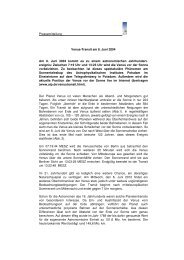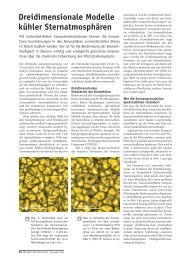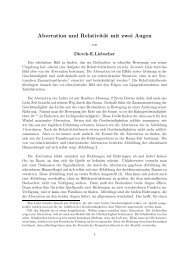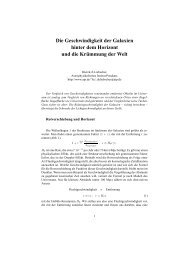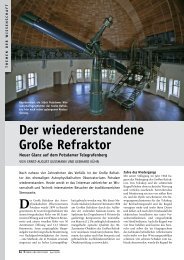Einsteins Relativitätstheorie und die Geometrien der Ebene - AIP
Einsteins Relativitätstheorie und die Geometrien der Ebene - AIP
Einsteins Relativitätstheorie und die Geometrien der Ebene - AIP
Erfolgreiche ePaper selbst erstellen
Machen Sie aus Ihren PDF Publikationen ein blätterbares Flipbook mit unserer einzigartigen Google optimierten e-Paper Software.
Geleitwort<br />
As a boy of 12, Einstein encountered the won<strong>der</strong> of Euclidean plane geometry<br />
in a little book that he called ” das heilige Geometrie-Büchlein“ ( ” the holy geometry<br />
booklet“). Something similar happened to Dierck Liebscher – though admittedly not<br />
quite at the ten<strong>der</strong> age of 12. As a physics student in Dresden, he heard lectures on<br />
projective geometry. The delight he got from these lectures has remained with him<br />
through his working life, and he has now passed on some of it in the present book.<br />
It is a rather unusual book and all the better for it. One of the sad things<br />
about the hectic pace and competitiveness of mo<strong>der</strong>n scientific research is that truly<br />
beautiful discoveries and insights of earlier ages get completely forgotten. This is very<br />
true of projective geometry and the great synthesis achieved in the 19 th century by<br />
Cayley and Klein, who showed that the nine consistent geometries of the plane can<br />
all be <strong>der</strong>ived from a common basis by projection. When Minkowski discovered that<br />
the most basic facts of Einstein’s relativity can be expressed as the pseudo-Euclidean<br />
geometry of space and time, Klein hailed it as a triumph of his Erlangen program.<br />
For it showed that the trigonometry of pseudo-Euclidean space is the kinematics of<br />
relativity.<br />
There is a very good reason why projective geometry is nevertheless not part<br />
of current physics courses. It can only be applied to spaces (or space-times) of<br />
constant curvature, and therefore fails in general relativity, in which the curvature<br />
in general varies from point to point. In such circumstances, one is forced (as in<br />
quantum mechanics) to use the analytical methods first introduced by Descartes.<br />
The beautiful synthetic methods of the ancient Greeks are not adequate. However,<br />
several of the most famous and important space-times that are solutions of Einstein’s<br />
general relativity, notably Minkowski space and de Sitter (and anti de Sitter) space,<br />
do have constant curvature. One of the high points of Liebscher’s book is the survey<br />
of all such spaces from the unified point of view of projective geometry. It yields<br />
insights lost to the analytic approach.<br />
Perhaps the single most important justification for this book is the advent of computer<br />
graphics and the possibility of depicting on the page views of three-dimensional<br />
objects seen in perspective. Drawings and constructions may be distrusted as means<br />
to proofs, but they do give true insight that can be gained in no other way. The<br />
diagrams of this book constitute its real substance and yield totally new ways of approaching<br />
a great variety of topics in relativity and geometry. Especially interesting<br />
is the treatment of aberration, which is a vital part of relativity that gets far too<br />
little discussion in most textbooks.<br />
This is not a textbook in any sense of the word. It is however a book that will<br />
instruct, deepen <strong>und</strong>erstanding, and open up new vistas. It will give delight to all<br />
rea<strong>der</strong>s prepared to make a modicum of effort. What more can one ask of a book?<br />
South Newington, January 1999 Julian Barbour





